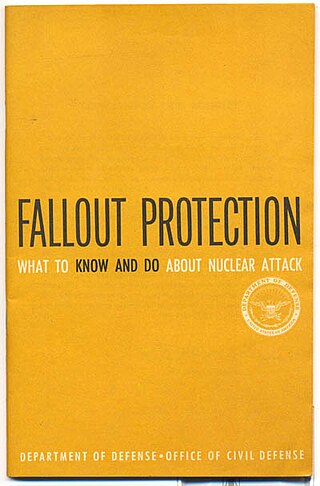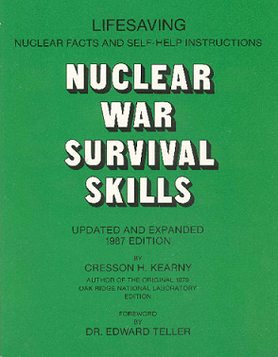
Civil defense or civil protection is an effort to protect the citizens of a state from human-made and natural disasters. It uses the principles of emergency operations: prevention, mitigation, preparation, response, or emergency evacuation and recovery. Programs of this sort were initially discussed at least as early as the 1920s and were implemented in some countries during the 1930s as the threat of war and aerial bombardment grew. Civil-defense structures became widespread after authorities recognised the threats posed by nuclear weapons.

A fallout shelter is an enclosed space specially designated to protect occupants from radioactive debris or fallout resulting from a nuclear explosion. Many such shelters were constructed as civil defense measures during the Cold War.

A nuclear weapon is an explosive device that derives its destructive force from nuclear reactions, either fission or a combination of fission and fusion reactions, producing a nuclear explosion. Both bomb types release large quantities of energy from relatively small amounts of matter.

Nuclear warfare, also known as atomic warfare, is a military conflict or prepared political strategy that deploys nuclear weaponry. Nuclear weapons are weapons of mass destruction; in contrast to conventional warfare, nuclear warfare can produce destruction in a much shorter time and can have a long-lasting radiological result. A major nuclear exchange would likely have long-term effects, primarily from the fallout released, and could also lead to secondary effects, such as "nuclear winter", nuclear famine, and societal collapse. A global thermonuclear war with Cold War-era stockpiles, or even with the current smaller stockpiles, may lead to various scenarios including the extinction of the human species.

Nuclear fallout is the residual radioactive material propelled into the upper atmosphere following a nuclear blast, so called because it "falls out" of the sky after the explosion and the shock wave has passed. It commonly refers to the radioactive dust and ash created when a nuclear weapon explodes. The amount and spread of fallout is a product of the size of the weapon and the altitude at which it is detonated. Fallout may get entrained with the products of a pyrocumulus cloud and fall as black rain. This radioactive dust, usually consisting of fission products mixed with bystanding atoms that are neutron-activated by exposure, is a form of radioactive contamination.
A cobalt bomb is a type of "salted bomb": a nuclear weapon designed to produce enhanced amounts of radioactive fallout, intended to contaminate a large area with radioactive material, potentially for the purpose of radiological warfare, mutual assured destruction or as doomsday devices. There is no firm evidence that such a device has ever been built or tested.

Nuclear technology is technology that involves the nuclear reactions of atomic nuclei. Among the notable nuclear technologies are nuclear reactors, nuclear medicine and nuclear weapons. It is also used, among other things, in smoke detectors and gun sights.

The Nevada National Security Sites, popularized as the Nevada Test Site (NTS) until 2010, is a reservation of the Department of Energy of the federal Government of the United States located in the southeastern portion of the Nye County in Nevada, about 65 mi (105 km) northwest of the city of Las Vegas.

Radiological warfare is any form of warfare involving deliberate radiation poisoning or contamination of an area with radiological sources.

Protect and Survive was a public information campaign on civil defence. Produced by the British government between 1974 and 1980, it intended to advise the public on how to protect themselves during a nuclear attack. The campaign comprised a pamphlet, newspaper advertisements, radio broadcasts, and public information films. The series had originally been intended for distribution only in the event of dire national emergency, but provoked such intense public interest that the pamphlet was published, in slightly amended form, in 1980. Due to its controversial subject, and the nature of its publication, the cultural impact of Protect and Survive was greater and longer-lasting than most public information campaigns.

Operation Teapot was a series of 14 nuclear test explosions conducted at the Nevada Test Site in the first half of 1955. It was preceded by Operation Castle, and followed by Operation Wigwam. Wigwam was, administratively, a part of Teapot, but it is usually treated as a class of its own. The aims of the operation were to establish military tactics for ground forces on a nuclear battlefield and to improve the nuclear weapons used for strategic delivery.

"Duck and cover" is a method of personal protection against the effects of a nuclear explosion. Ducking and covering is useful in offering a degree of protection to personnel located outside the radius of the nuclear fireball but still within sufficient range of the nuclear explosion that standing upright and uncovered is likely to cause serious injury or death. In the most literal interpretation, the focus of the maneuver is primarily on protective actions one can take during the first few crucial seconds-to-minutes after the event, while the film of the same name and a full encompassing of the advice also cater to providing protection up to weeks after the event.

Duck and Cover is a 1952 American civil defense animated and live action social guidance film that is often mischaracterized as propaganda. It has similar themes to the more adult-oriented civil defense training films. It was widely distributed to United States schoolchildren in the 1950s, and teaches students what to do in the event of a nuclear explosion.

The Diefenbunker, formerly known by its military designation, Canadian Forces Station Carp (CFS Carp), is a large underground four-storey reinforced concrete bunker and nuclear fallout shelter located in the rural area of Carp, Ontario approximately 30 km (19 mi) west of downtown Ottawa. Between 1957 and 1961, during the Cold War the Government of Canada led by then Prime Minister John Diefenbaker authorized the Diefenbunker to be designed and built as the Central Emergency Government Headquarters (CEGHQ Carp) in an attempt to ensure the continuity of government subsequent to a nuclear weapons attack by the Soviet Union. In 1994, CFS Carp was decommissioned and closed.
Geiger counter is a colloquial name for any hand-held radiation measuring device in civil defense, but most civil defense devices were ion-chamber radiological survey meters capable of measuring only high levels of radiation that would be present after a major nuclear event.

Nuclear safety is defined by the International Atomic Energy Agency (IAEA) as "The achievement of proper operating conditions, prevention of accidents or mitigation of accident consequences, resulting in protection of workers, the public and the environment from undue radiation hazards". The IAEA defines nuclear security as "The prevention and detection of and response to, theft, sabotage, unauthorized access, illegal transfer or other malicious acts involving nuclear materials, other radioactive substances or their associated facilities".

United States civil defense refers to the use of civil defense in the history of the United States, which is the organized non-military effort to prepare Americans for military attack and similarly disastrous events. Late in the 20th century, the term and practice of civil defense fell into disuse. Emergency management and homeland security replaced them.

Fallout Protection: What To Know And Do About Nuclear Attack was an official United States federal government booklet released in December 1961 by the United States Department of Defense and the Office of Civil Defense. The first page of the book is a note from then-U.S. Secretary of Defense Robert McNamara explaining that the booklet is a 48 page book made for the result of the first task he was given when he assumed responsibility for the Federal Civil Defense Program in August 1961. The task, assigned by President John F. Kennedy, was to "give the American people the facts they need to know about the dangers of a thermonuclear attack and what they can do to protect themselves."

Nuclear War Survival Skills or NWSS, by Cresson Kearny, is a civil defense manual. It contains information gleaned from research performed at Oak Ridge National Laboratory during the Cold War, as well as from Kearny's extensive jungle living and international travels.
A salted bomb is a nuclear weapon designed to function as a radiological weapon by producing larger quantities of radioactive fallout than unsalted nuclear arms. This fallout can render a large area uninhabitable. The term is derived both from the means of their manufacture, which involves the incorporation of additional elements to a standard atomic weapon, and from the expression "to salt the earth", meaning to render an area uninhabitable for generations. The idea originated with Hungarian-American physicist Leo Szilard, in February 1950. His intent was not to propose that such a weapon be built, but to show that nuclear weapon technology would soon reach the point where it could end human life on Earth.

















